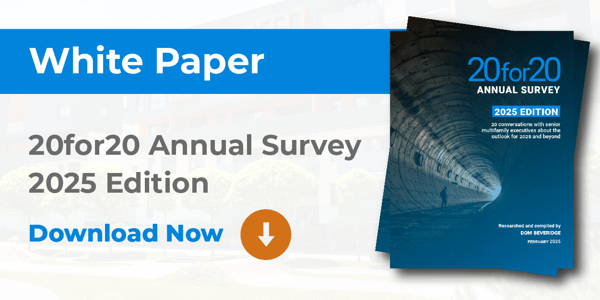
Another outstanding AIM conference is in the books. It was a terrific few days in Huntington Beach—with what felt like the best ever crowd in this event's long and successful history. Among the many interesting conversations at the show, some focused on topics familiar to readers of this blog, a few of which are outlined below.
More Centralization
Cenralization for third-party management is a hot topic du jour in these pages. I got to explore it on stage with Heidi Turner of Blanton Turner and Kara Althmann, formerly the COO of Cardinal Group. The session yielded a healthy dose of firsthand experience, most interestingly about what it is like to pitch centralized services to ownership groups.
A crucial difference between third-party managers and owner-operators is that changing the operating model entails a negotiation between the owner and operator and an amendment to the property management agreement.
That, as the panelists' experience revealed, opens the door to many complexities, including, for example, that lenders are not always motivated to accept changes to familiar contract structures. Rolling out centralization requires operators to find ways to overcome many obstacles like these. However, as this session demonstrated, fee managers are increasingly finding ways to persuade ownership groups and to take the next step.

Unraveling Renewals
I also got to moderate a fascinating conversation entitled "Why are everyone's renewal rates up?" It picked up a topic I recently discussed on Jay Parsons' podcast, and a major finding from this year's 20for20 Annual Survey: the surprise uptick in retention rates across much of the industry.
We know, of course, that renewal decisions are multifactorial, and there are many explanations of what may be causing retention to be up. This roundtable added a diversity of direct experience and some new observations.
A few companies with mixed affordable and market-rate portfolios shared that rents for the two product types are now at parity in some markets. As residents trade up to higher-quality product, these operators find themselves in the unusual situation of struggling to find enough qualified residents to fill affordable units. They had been forced to establish marketing budgets for their affordable properties for the first time. Retention was generally up in market rate and unusually challenging in affordable properties.
Another interesting wrinkle of external forces and internal tactics came from one portfolio that spread from the mid-Atlantic to the southeast. Residents had migrated south over the last few years and are now showing signs of returning to the mid-Atlantic markets. The challenge, then, is to use the renewal conversation to identify residents moving to a market where the operator also has properties and provide them with the opportunity to stay in the portfolio. A proactive, technology-enabled renewal process and some effective marketing are helping this company drive retention at a portfolio level.
Tactics and creativity
That story spurred a highly energetic conversation about the renewal process. One leader trained site teams to "put on customer goggles" rather than financial ones in preparing for the renewal conversation. That involves reviewing each resident's service history, shopping comps and turning the renewal process into a tailored conversation rather than a one-way offer.
One company had even introduced monthly renewal parties. They featured a service request booth, handling maintenance issues—no matter how trivial—on the spot, in a convivial environment. The community pre-printed renewal agreements for each guest. Residents could talk freely to one another in a highly transparent process, which resulted in renewal take rates of above 80% on the spot.
Speaking of transparency...
Fee transparency appears to be becoming an increasingly important story in multifamily marketing, and the topic was covered at a couple of sessions at AIM.
With legislators targeting junk fees at various levels, and renters increasingly frustrated at opaque and sometimes misleading pricing information, the industry seems motivated to do better at separating rent from ancillary fees. Tech providers and ILSs are reacting to support more transparent pricing regimes. As this approach gains ground, there will be important consequences for marketing and pricing strategies.
So much tech
Finally, I attended an interesting mainstage conversation between some technology leaders about the increasing problem of vendor management. The subject chimes with the general observation that from this year's 20for20: there is generally a lot of tech in multifamily at the moment. With more apps and more non-IT actors purchasing them, contract management seems to be a big enough problem that companies are rolling out technology to regain some control.
From private conversations around the event, there seems to be a growing number of elephants in the room when we talk about tech decision-making. Vendor management is, of course, a good idea, but it is downstream of the real technology decisions, which are increasingly being made for reasons other than operational improvement-based ROI. As this year's Annual Survey noted, that is making tech stacks and resident experiences messier.
That is a topic to which I plan to return later in the year, and I am excited to be moderating a panel on the subject at Blueprint in the fall. I can't wait to litigate this important topic a little more with a seasoned panel of tech evaluators.
But for now, we must once again join in congratulating Steve and Dennis for continuing to deliver so successfully one of the industry's great institutions. I can't wait for AIM 2026!



